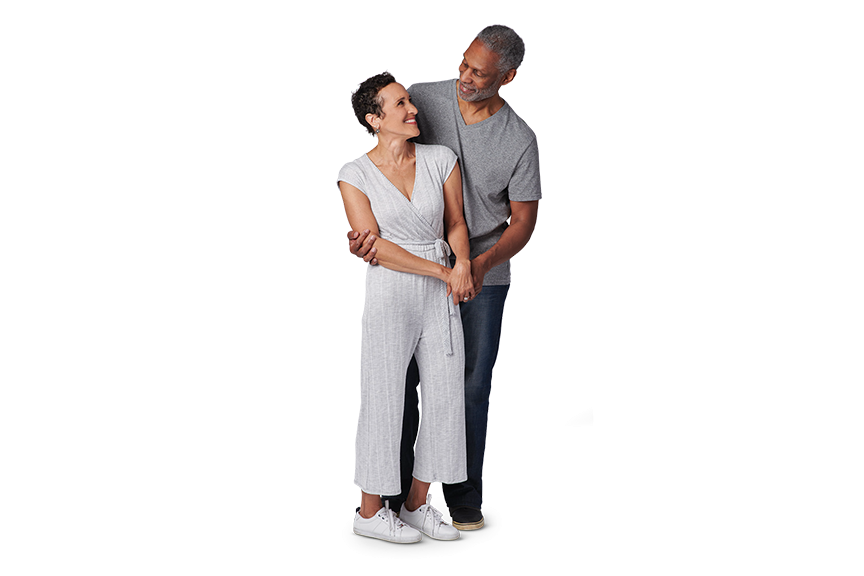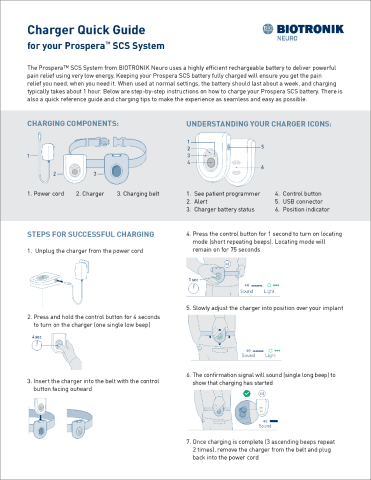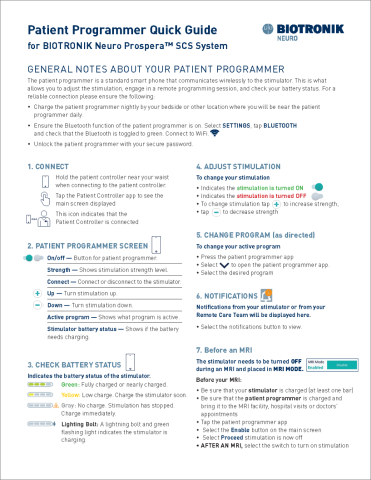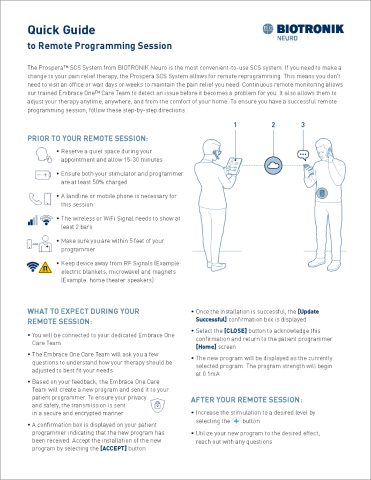MyProspera
Resource Center
Instructions and tips to help you get the most out of your Prospera® Spinal Cord Stimulation System.
Find the information you need as you Embrace Life Again.

Therapy Quick Guides

Charger Quick Guide

Programmer Quick Guide

Remote Programming Quick Guide
Frequently Asked Questions
Who is my primary BIOTRONIK Neuro contact?
After your Prospera SCS stimulator is implanted, your primary point of contact is your dedicated Embrace One Care Team. With your consent, your Embrace One Care Team monitors your stimulator remotely to ensure you maintain the most optimized level of therapy. You can reach your Embrace One Care Team at (971) 206-6111.
Your local BIOTRONIK Neuro representative and dedicated Embrace One Care Team work together throughout your journey and the lifetime of your therapy. If your stimulator needs troubleshooting, your local BIOTRONIK Neuro representative may attend your doctor’s appointment if needed.
How can I order a replacement patient ID card, programmer, charger, or other supplies?
Please contact your Embrace One Care Team at (971) 206-6111.
What does the stimulation feel like?
In general, there are two types of stimulation: paresthesia and nonparesthesia. In paresthesia stimulation, you may experience a vibrating or tingling sensation that overlaps the areas where you typically feel pain. Nonparesthesia is a newer form of stimulation that provides pain relief without any vibrating or tingling sensation. Your system has the ability to deliver both types of stimulation.
How often does my stimulator need to be reprogrammed?
Your stimulator only needs to be reprogrammed if your pain is not being adequately relieved. If you think your therapy needs to be adjusted, reach out to your doctor or Embrace One Care Team.
How often and for how long should I recharge my stimulator?
This depends on your unique programming and how much energy you use. Depending on your settings and schedule preferences, you may charge your device once per week, or multiple times per week. Charging typically takes 1 hour, but may take longer depending on the time you are waiting between charges.
If I’m having more pain, should I turn up the strength of stimulation on my programmer?
Not necessarily. Higher strength does not always lead to more pain relief. Your therapy programs have been carefully set up by your Embrace One Care Team and/or local BIOTRONIK Neuro representative in consultation with your doctor. If your pain returns and you have questions about your therapy programs, call your doctor or Embrace One Care Team to discuss how to best optimize your therapy.
Can I use a heating pad?
Avoid placing a heating pad next to or on top of your charger while charging your stimulator. High surrounding temperature may cause disruption to charging.
Do I need to take extra precautions when I travel?
Your programmer has a 5G data plan that supports service in the US and internationally. The Embrace One phone line accepts international calls from 8 AM to 8 PM Eastern time. When traveling, BIOTRONIK Neuro will continue to monitor your device as long as your programmer has cellular coverage or is connected to WiFi.
At travel security checks, do not pass through the metal detector. Instead, show your patient ID card to security personnel. Request a manual screening, and ask the security personnel not to hold screening devices near your stimulator for longer than required.
On the airplane, be sure to put your programmer into airplane mode. Do not use your charger.
Is exposure to electromagnetic fields safe?
Electromagnetic fields may affect your SCS system. To prevent any adverse effects, we recommend avoiding situations with especially risky electromagnetic fields. (Examples of sources of strong electromagnetic interference may include: commercial electrical equipment, communication equipment, high-voltage power lines, power generators, theft detectors, security screeners, radiofrequency identification readers, or strong magnets.) If it’s not possible to avoid these situations, temporarily turn off stimulation before coming into contact with electromagnetic activity.
If you do come into contact with electromagnetic interference, this can lead to a malfunction of the system. Once you move away from the source of interference, check your stimulation and notifications on your programmer. If you suspect any malfunction, contact your doctor or Embrace One Care Team to schedule an appointment to check your system.
Is diagnostic imaging or testing safe?
Because they may pose a risk to you as a patient or may damage your SCS system, some diagnostic procedures or medical treatments must be avoided.
Other procedures may only be performed with special precautions. Please consult your healthcare provider and inform them of your SCS system when considering diagnostic or medical treatments. Examples of these procedures may include, but are not limited to:
• Diathermy
• RF ablation (tissue sclerotherapy)
• Surgery that will use electrocautery
• Therapeutic ultrasound
• Hyperbaric oxygen therapy
• Magnetic resonance imaging (MRI)
Is it safe to undergo an MRI?
MRI scans are possible if certain conditions are met. All external components like the trial stimulator, charger, charger belt, and programmer should not be taken into the MRI room. Before undergoing an MRI scan, inform the examining doctor about your SCS system. Additionally, you will need your patient programmer to enable MRI mode before the MRI scan. For instructions on how to enable MRI mode, please refer to your Patient Programmer Quick Guide or contact the Embrace One Care Team.
Still have a question?
Embrace One™ is a support platform intended to help manage a patient’s experience with spinal cord stimulation. It is not intended to be used for medical diagnosis or medical treatment.

Brief Summary: Please reference the appropriate product Instructions for Use (IFU) for more information regarding indications, contraindications, warnings, precautions, and potential adverse events. Indications for Use: The Prospera® Spinal Cord Stimulation (SCS) System is indicated as an aid in the management of chronic, intractable pain in the trunk and/or limbs, which may include unilateral or bilateral pain. Contraindications: Implantation of a spinal cord stimulator may be contraindicated in patients who are unable to operate the SCS system, or who have failed to receive effective pain relief during SCS trial stimulation, or who are poor candidates for surgery. Note that the safety and effectiveness of Prospera SCS system has not been established in pediatric patients or pregnant or nursing patients. Warnings: The following may cause electromagnetic interference, adverse interactions, insufficient or excessive stimulation, damage and function loss of the system, and/or therapy failure: external defibrillation, transcutaneous electrical nerve stimulation (TENs), lithotripsy, RF ablation, hyperbaric oxygen therapy, electrocautery, diathermy therapy (including shortwave, microwave, and therapeutic ultrasound therapies), high-power ultrasound, radiation therapy, Magnetic Resonance Imaging (MRI) scan (refer to Prospera SCS System MRI Guidelines for the system’s MR conditional information), use of portable RF communication equipment near the SCS system, use of a non-BIOTRONIK-provided charger. The Prospera SCS System may interfere with the operation of implanted pacemakers or ICDs. The effects of an implanted Prospera SCS System on other neurostimulators are unknown. Precautions: Device malfunction, loss of therapy, and other adverse events including patient injury may occur if the device is not handled or operated properly as described in the IFU. Refer to the product IFU for comprehensive safety messages when handling the device. Potential Adverse Events: Risks associated with SCS system placement: pain at the implant site, infection, cerebrospinal fluid (CSF) leakage, CSF fistula, epidural hemorrhage, bacterial meningitis, seroma, hematoma, paralysis. Additional risks associated with SCS system use: lead migration; stimulator migration; allergic response or tissue reaction to the implanted system material; skin erosion; radicular chest wall stimulation; disturbed urination; dysesthesia; decubitus; premature battery depletion; and uncomfortable stimulation or ineffective pain management. Furthermore, there is the risk that the SCS therapy may not be effective in relieving symptoms or may cause worsening of symptoms. Refer to the product IFU for a comprehensive list of potential adverse events.